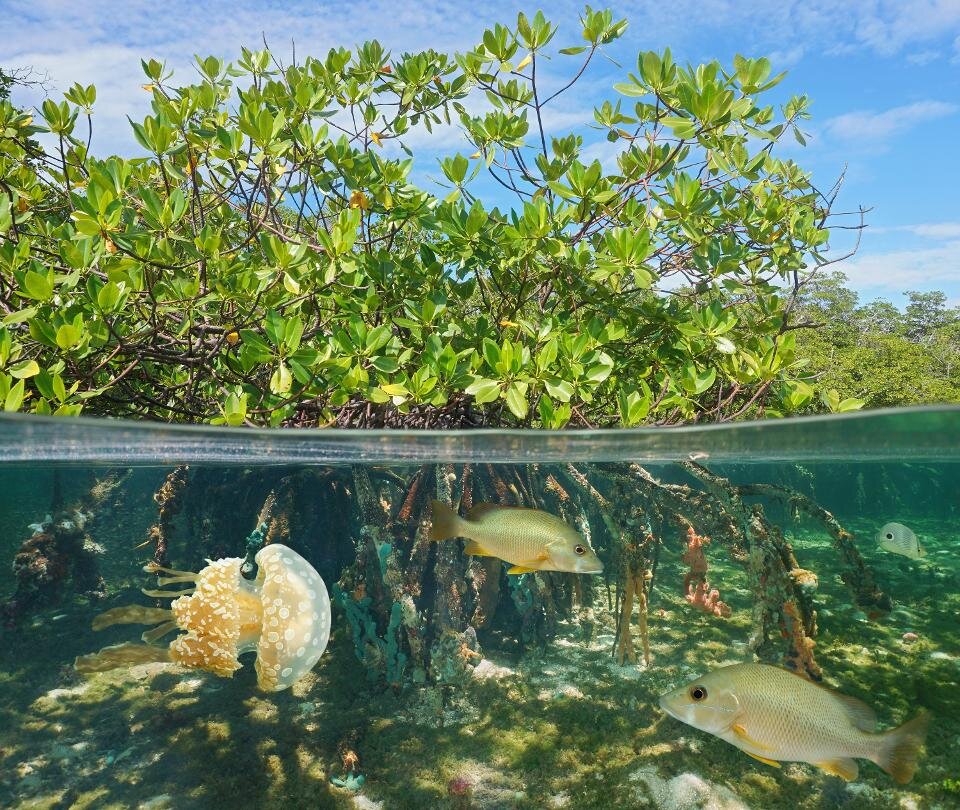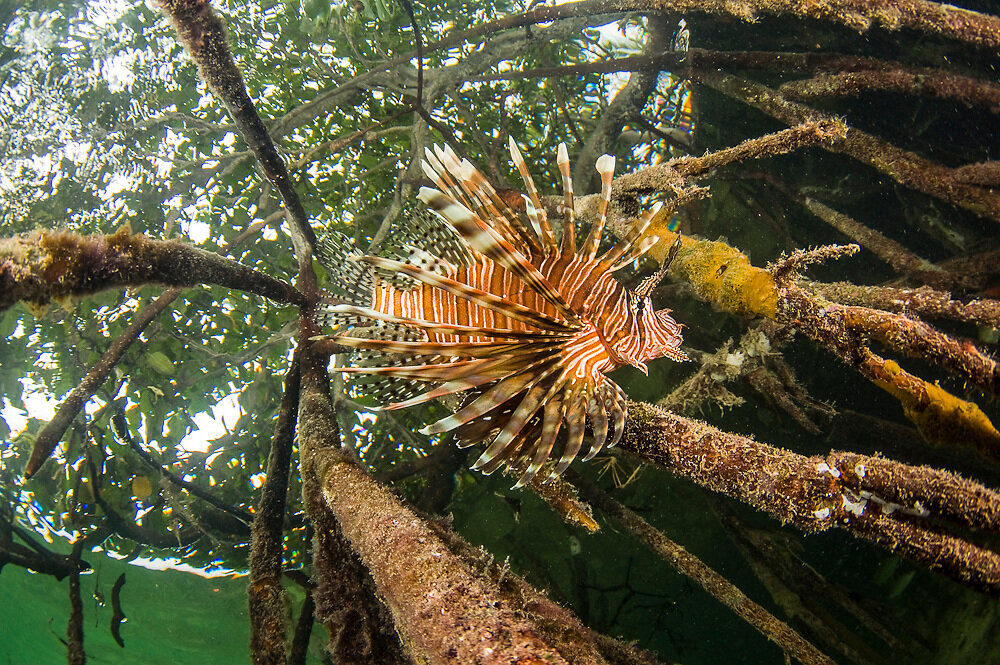The Mangrove Creek
About the Mangrove Ecosystem
Mangroves are one of the most valuable ecosystems around the world and especially in The Bahamas and other coastal regions. Mangroves are single handedly responsible for the succession of ocean to land. They are the only tree that can grow in saline conditions due to their different adaptations.
Just like any other tree, mangroves require freshwater, sunlight and oxygen. However, because they often grow marine environments, they lack easy access to freshwater and oxygen. Mangroves have developed a way to absorb salt water and separate the salt from the water. Some mangroves have the ability to reject the salt from entering the plant, while other simply extract the salt after it has been absorbed. Mangroves also require sunlight to thrive, but because they have to conserve their water, they have very thick waxy leaves to slow down transpiration [the loss of water].
There are 4 different types of mangroves, red, black, white and buttonwood. Each of these mangroves grows in a specific area to fill their niche.
The Red Mangrove. This mangrove species is found in the deeper water of the creek and is characterized by its red, prop roots, which create a safe haven for young marine animals.
Fish and Jellyfish in the roots of the Red Mangrove
Photo Credit: Google Images
The Black Mangrove. These are found in very shallow water and is identified by the salt at the back of its leaves and its pneumatophores. The pneumatophores grow from their roots and act as a snorkel, allowing them to get oxygen from the surface.
Salt on the back of a Black mangrove leaf
Photo Credit: Smithsonian Website
Pneumatophores of the Black Mangrove
Photo Credit: Google Images
The White Mangrove. White mangroves are found on nearly dry land. They have nectar nodes at the base of their leaves that attract insects. These mangroves also can produce pneumatophores, however it is rare.
White Mangrove
Photo Credit: Google Images
The Buttonwood Mangrove. is found on completely dry land. These mangroves have small brown clusters that resemble buttons. There are two types of Buttonwood. Regular buttonwood, which has green leaves and Silver Buttonwood, which has silvery, green leaves. Silver buttonwood is often used in landscaping.
Buttonwood Mangrove
Photo Credit: Google Images
Silver Buttonwood
Photo Credit: Google Images
Importance of Mangrove Creeks
Habitat. The mangrove creek is home to marine life and other species like birds, snakes, crabs and small insects.
The roots of the Red Mangroves act as a nursery for many marine animals. This is because only smaller marine animals can maneuver through them and this protects smaller animals from larger prey. The majority of The Bahamas’ main fishery species start their lives in the mangrove creek area, for example, the spiny lobster, queen conch, nassau grouper and many species of snapper. Marine animals move through the mangrove creeks with the tides. At higher tides larger animals move into the mangrove because there is more space for them to swim around, this pushes smaller animals further into the mangrove. At lower tides the larger animals move out of the creek and smaller animals are free to move out.
Fish in the roots of the Red Mangrove
Photo Credit: Google Images
Many birds enjoy life in the mangrove creek. Wading birds like the green heron and yellow crowned night heron can be found fishing in the red mangrove. Other birds like ibis, mangrove cuckoo and even some warblers can be found through the branches of the Red, Black, White and Buttonwood mangroves.
Great White Heron in mangrove creek
Photo Credit: Google Images
Cuban Yellow Warbler in the Black Mangrove
Photo Credit: Google Images
In the branches of some mangroves you can spot native snakes like the Bahama Boa constrictor or Brown Racer. Different species of crabs like hermit crabs can be seen running through the soil of the Black, White and Buttonwood mangroves or even on the seafloor in the Red Mangrove. Insects also benefit from the mangrove habitat and can be found crawling up the branches or flying around.
Boa Constrictor in Red Mangrove
Photo Credit: Google Images
Land Crab in Red Mangrove roots
Photo Credit: Google Images
Land Protection. Mangroves break down wind and wave action onto the land, which protects the land from erosion and flooding. The prop roots of the Red Mangrove greatly reduces wave action. By doing this, the waves are slowed down and sometimes even eliminated. The root systems of the mangroves are very dense and this solidifies the soil that has been built up by the mangroves and holds it in place to combat water erosion. The branches and leaves of the mangroves reduces and can fully block the wind action and protects the coast from wind erosion.
Improving water and air quality. The complex root systems of the mangroves not only build up sediment, but also filters out excess nutrients, toxins and other pollutants. These nutrients, toxins and pollutants are absorbed by and bound to the sediments that the mangroves collect. By absorbing and eliminating these substances, the mangroves prevent eutrophication and also protects other ecosystems like the coral reefs or sea grasses from being smothered by sediments. Mangroves also have the ability to absorb carbon dioxide, which reduces the presence of carbon dioxide in the atmosphere. By reducing the carbon dioxide, mangroves reduce the greenhouse effect and thus global warming.
Red Mangrove in Conception Island, The Bahamas.
Photo Credit: Google Images
Cultural uses. Culturally, mangroves have been used to make different teas from the leaves of mangroves. Bahamians also use mangroves for medicinal purposes like the black mangrove for hemorrhoids, gastrointestinal and skin problems. Buttonwood is also used medicinally for treating sores and cuts.
Historically, mangrove wood has been used for many things. These include furniture and boat making, dying and cooking. Tannins from wood of the red mangrove can be used in dyeing leather and other materials. Buttonwood was used to smoke and barbecue meats because it has a unique flavor. Because mangroves do such a thorough job of slowing down wings and waves during storms, boat owners often store their boats within the mangrove creek.
A boat tied in the Mangrove Creek
Photo Credit: Google Images
Threats to Mangroves
Just like other ecosystems, mangroves face many threats.
Dredging. Many persons are not aware of the overall importance of the mangrove creek. Therefore, they often dredge out these areas to create canals and areas for boats to pass.
Mangrove Dredging
Photo Credit: Google Images
Pollution. Unfortunately, pollution is a large problem worldwide especially in The Bahamas, where it is harder to monitor areas. Physical pollution can smother the roots of the mangroves, which already have low access oxygen, and eventually kill the plants. Physical pollution also can trap and kill young marine animals. Chemical pollutants like runoff of excess nutrients can cause eutrophication, which is the overgrowth of algae. If algae growth in the water is not able to be monitored, it can reduce the availability of oxygen and therefore kill the species in the area.
Pollution in the mangrove
Photo Credit: Google Images
Invasive species. The two main invasive species that can be found in and near the mangrove creek are the Lionfish and the Australian Pine, respectively.
Lionfish are gluttonous feeders and greatly reduce the marine populations within the mangroves. Because mangroves are nurseries, the majority of the marine species found in this area are immature. Therefore if they are eaten by Lionfish, they are not able to reproduce and this causes their populations to greatly decrease. There are no natural predators to the Lionfish because they are not native to The Bahamas or the Caribbean. Therefore their populations can only be managed by humans.
Lionfish in the roots of the Red Mangrove
Photo Credit: Google Images
The Australian Pine is an invasive pine tree that can be found on every coast in The Bahamas. These pines are salt tolerant and can compete with mangroves that grow on drier land. Australian Pines have very shallow roots and aid in coastal erosion, which is counter productive to the jobs of the mangroves. These pines also have slightly acidic needles that change the pH of the soil surrounding these trees. This change in soil pH prevents other trees from thriving wherever Australian Pines are growing.
Australian Pine
Photo Credits: Google Images
Deforestation. Many hotels and housing developments have cut down mangroves to have beach access and beach views. However, in more recent times, they have realized that this eventually causes great damage to the buildings that are constructed near by. An example of a development that was once a mangrove creek is Queen’s Cove in North-West Grand Bahama. This area constantly floods and is no longer the prominent housing development it once was.
Mangrove Deforestation
Photo Credits: Google Images



















